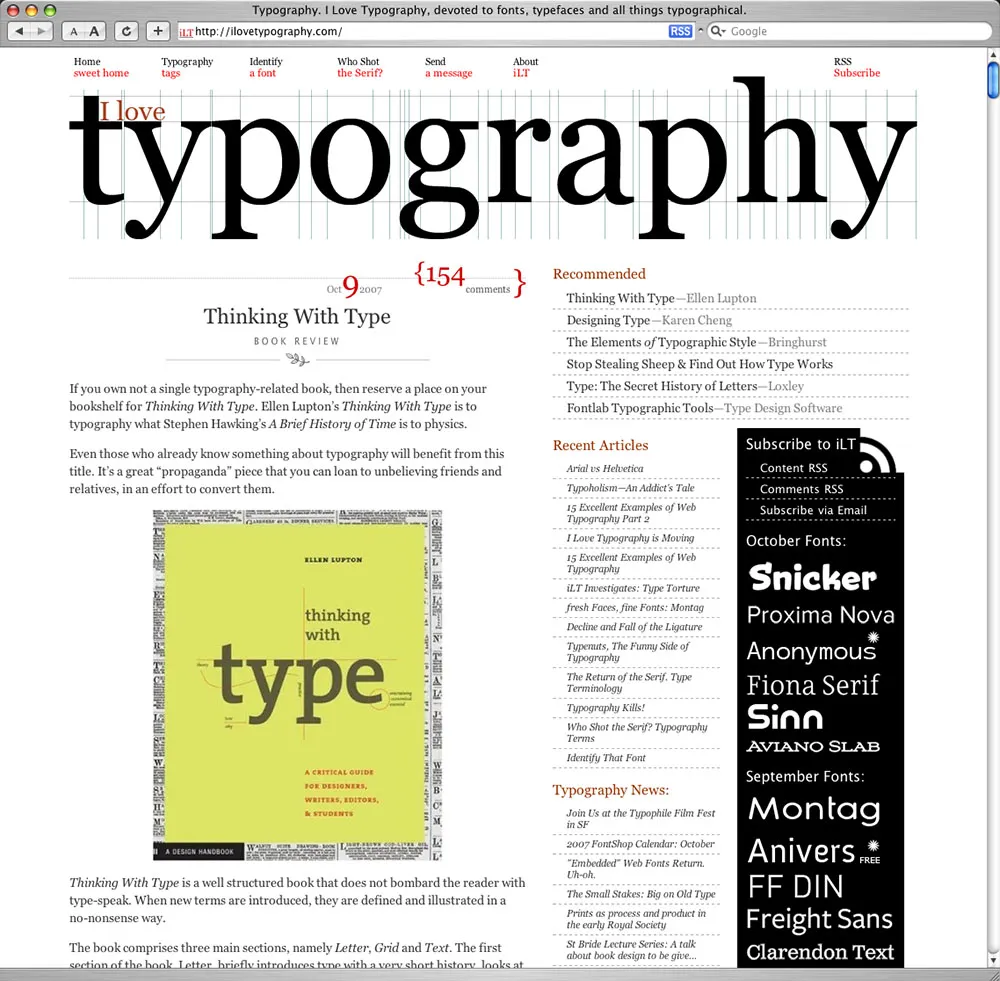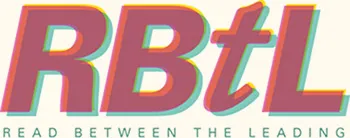
I just recently became aware of a new type-related site called I Love Typography. It’s only been around about two months, but it’s already shaping up to be one of the best.
What’s different about iLT from other type sites is its emphasis on longer articles, particularly ones covering typographic fundamentals. Readers may also comment, but that’s a secondary element. The venerable Typographica promised to do this a few years ago, but, for whatever reason, it didn’t really work out. (To be fair, I still love Typographica. It’s been a little quiet, but things have been picking up.) In any case, iLT’s author, John Boardley, has picked up the baton and run with it. It’s a great start and I wish him best of luck.
This one was news to me: Jean François Porchez, proprietor of Porchez Typefoundrie in France, has a personal weblog called Chez Porchez. He also has a hand in the French type blog Le Typographe.com.
Berlin-based Erik Spiekermann, designer of the ubiquitous Meta, has one called spiekerblog. According to a recent interview on typeradio, he created it so he wouldn’t have to answer so many emails asking the same questions over and over.
Finally, one of the first weblogs I ever knew about was Grant Hutchinson’s splorp blog. As a type designer, he was responsible for a large portion of the old Image Club type library. Image Club is no longer around, but, after several changes of hands, many of their fonts still are available through Agfa Monotype, including his ever-popular Fajita. Grant is now at Veer in Calgary, Alberta, which he helped start up with his Image Club cohorts. [Update: Veer no longer exists, so I removed the link.]
Earlier today I watched this wonderful presentation by Jeremy Keith that he gave at the Build conference. He touches on something I’ve thought about for a long time, going back even before personal computers: The long term prospect of the media we record things on—paper, records, magnetic tape, film, video tape, floppy disks, compact disc, DVDs, hard drives and servers.
I had almost the same thought as Jeremy: I picture archaeologists in the distant future studying what remains of our culture and finding lots of documents and records right up until around the end of the twentieth century—and then almost nothing that can be read or decoded.
Printed books, artwork, typed and written manuscripts, photos on film and paper, with all of these media, you can either read and decode it directly with your eyes. It may be faded or fragile, but if it survives, whatever is recorded on it will survive. Even movies on film and phonograph records could be reverse-engineered just by using observations and common sense, even if some of the nuances may be lost.
Then you get to magnetic tape. If you’ve never seen it before, it’s not obvious what it is, and even if you guessed correctly, the magnetic signals on the tape fade over time and the tape itself deteriorates.
Things start getting really bad when you go to analog video tape. To even make sense of what’s on the tape—assuming you figure out that it’s some kind of motion picture medium—you would need to reinvent the television and video tape player. Very difficult, but conceivable.
All bets are off when you get to digital storage, which Jeremy gets into in detail in his presentation. To me, it seems that it would be nearly impossible to recover anything stored digitally if, in some cataclysm, the knowledge of computer technology was lost.
Even things from the recent past are getting difficult to access. I switched to digital tools for most of my design and artwork in the late 1980s. Some of the work I did—in the form of PageMaker files, for example—I would have a difficult time retrieving. Yes, technically, much of this stuff can be accessed if you have old enough hardware and software. But hardware doesn’t last forever, and what about more recent software that requires internet activation?
When I look back through my old artwork, I have less and less in the form of physical objects—drawings, photos, printed samples. Physical objects get old, faded, and damaged, but you can still hold them, and look at them. Digital stuff never gets old or faded, but if even a few bits of data are corrupted, an entire file or disk can be lost forever, even if you still have something to read the media.
Then I think, who cares, other than pack rats like me? I thought the same thing watching Jeremy’s talk. Sure, huge amounts of digital culture may be—probably will be—lost to the future. But remember, there are many things from the past that are lost to us now because they happened before sound and picture recording—musical performances, theatrical performances and speeches, historical events. But lots of stuff did survive and will survive. We still print tons of books and magazines (so far). People still keep journals and diaries, and artists still keep sketchbooks.
Ultimately, culture is for the living. If it survives to be studied and appreciated by people in the future, great, and I hope it does. If not, I’m sure they’ll be busy making their own anyway.

I’m the featured guest on episode #6 of the typography and design podcast Read Between the Leading.
David Steinlicht is a graphic designer and illustrator here in St. Paul. He also does some very funny cartoons on his website, allsmall.net. Not to be missed is his series called On My High Horse, which is a bit like a blog in cartoon form (though I’m sure David would never call it that).
Dan Picasso (yes, that’s his real name) is an illustrator who divides his time between Marathon, Texas and Minneapolis. He’s something of an old car buff (he owns a ’56 Olds 88 that looks like it just drove off a showroom floor) and does his illustrations the old-fashioned way, with an air-brush, paint and paper.
Alfredo Zelcer was my boss when I worked as a designer on TWA Ambassador magazine many years ago. His website is a recent development and shows just a tiny glimpse of his talent. **Update:**Alfredo died in May 2011. His site has disappeared so I’ve removed the link, but his profile is still up at Facebook.
I’ve been getting a number of emails lately from people wanting to know what I think of the recent controversy surrounding some documents shown on 60 Minutes concerning President Bush’s military record which are said to be from around 1972. I’m not going to comment on it here, but I and many others have been expressing our opinions about it on Typographica where Scott Stowell posted an item about it last Friday.
I will say one thing: I don’t know as much about 1970s typewriters as I’d like to. Typewriters are like type in the way that bicycles are like motorcycles. Being an expert on one doesn’t necessarily mean you know much about the other.
